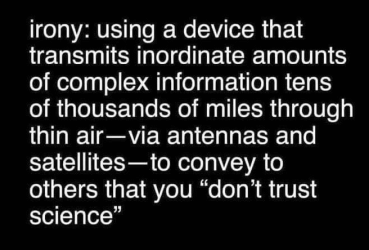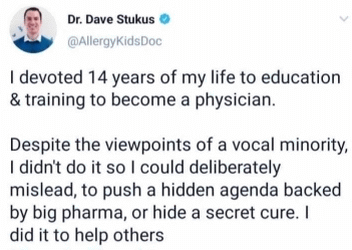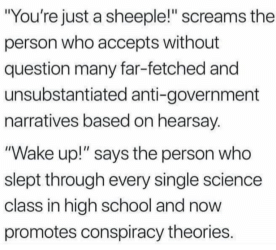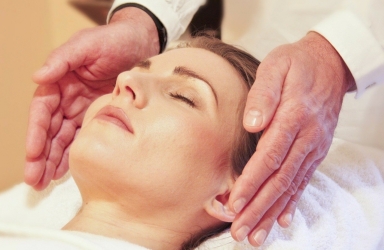 Skepticism is not a bad thing. A skeptical person simply asks for evidence before accepting a claim as valid. This is certainly true in the scientific world. However, often what is labeled 'healthy skepticism' is really cynicism or distrust. Itís not being skeptical to automatically assume the media or scientific experts are lying. Thatís just being cynical. 
 This page full of useful information, and is quite long, with many sections. Use the Index below to explore the various sections without having to scroll; use the 'Return to Index' link at the end of each section to return to the index. Recognizing Pseudoscience It's important to know the difference between real science and what is often called pseudoscience. Pseudoscience is hard to define, and there is always disagreement about what is and isn't fake science. Usually scientists label a claim as pseudoscience when the researchers donít follow the usual methods for obtaining and reporting evidence. Quite often unsupported or erroneous claims are used to sell products or validate a certain ideology or lifestyle. We're going to show you how to recognize fake science. Sometimes it will be obvious, but often the reason for labelling something as 'pseudoscience' is simply because there is no evidence to support it. The scientist and science writer Carl Sagan once said "Extraordinary claims require extraordinary evidence". In other words, if you expect us to accept your radical theory that the earth is flat, you'd better have some pretty convincing evidence to back it up. Another problem people have in recognizing fake science is that they don't understand how science works. I've witten about theories in science here, but here's a quick synopsis. In science, there are no absolute unchanging facts. Everything is a theory. The 'truth' of a theory is based on how well accepted it is by other scientists in the same field, and how well it agrees with other scientific ideas. Existing theories, even ones that have been accepted as correct for centuries, are always being modified, changed, or added to. This doesn't make them wrong. Theories are never 100% correct ... they're always being improved as our knowledge increases. The theory of gravity, for example, is pretty well understood, beginning with Isaac Newton, and few would argue that it's the attractive force that keeps us stuck to the earth, and that keeps planets in orbit. Yet gravity is still being studied, most rcently by Albert Einstein and Stephen Hawking, and we're learning new things about how it acts at a distance, and we'e discovering that there's a lot we still don't know. It's as if what we know about gravity is 98% 'correct', with the remaining 2% constantly changing. The fact that the theory about gravity is only 98% correct doesn't make it wrong. So when a misinformed critic says "The notion that the earth is a sphere is only a theory!", he's really not saying anything at all. Everything in science is a theory! It's all about the evidence! So how is an ordinary, reasonably intelligent but non-scientific person able to distinguish real accepted science from fake science? That's what we hope to show you. Return to Index Authorities First, let's look at the 'experts' argument often used as evidence of a theory's validity. Reliance on an authority is a well-accepted technique for winning arguments. However, it doesn't always work well in science. It's not that 'the authority' is necessarily wrong. But sometimes they are. Teachers, for example, used to teach strictly from a textbook, which didn't work very well in a science like astronomy where new things are constantly being discovered, making textbooks full of errors often before they're even published. How many people remember being taught in school that the planet Mercury is very hot on one side because that side always faces the Sun? Teachers taught that 'fact' for years because the textbook said it was true. (I was interested in astronomy when I was in high school, and particularly in black holes. I had difficulty getting current information because the city where I lived had few up-to-date astronomical resources in either the library or the bookstores. However, my problem solved itself in my first year at the University of Toronto when I discovered that the professor teaching my astronomy class had participated in the discovery of the first black hole. Talk about a good authority!) [Incidentally, good teachers no longer teach just from a textbook. They use a variety of sources, and often will encourage their students to look for their own. Teachers now are always open to new ideas, and willing to question accepted practices if there doesn't seem to be supporting evidence. You can read more about these and other ideas on my page about teaching practices.] The difficulty lies in what we consider to be an 'authoritative source'. Often in science it's another scientist. However, being a scientist does not necessarily make you an authority! Here's an example. You have a bad toothache. Obviously the expert to consult here is a dentist. You wouldn't visit a thoracic surgeon. Similarly if you want to find out about the likelihood of finding evidence of past life on Mars, you'd ask a Mars expert; you wouldn't ask an entomologist. Scientific fields are very specialized. The more education and training a scientist has, the more compartmentalized his or her knowledge. Here's an example of where this causes problems. The science of climate change is sometimes contentious, and not accepted by people who disagree with it, and who will enlist the opinions of like-minded scientists as authorities. But of course those scientists almost always are not authorities in climate science, no more so than you or I. Even meteorologists aren't experts in climate, which isn't the same as weather. There are only about a thousand climate scientists on the planet, who are the only true authorities on the topic of climate change, and 98% of them agree that climate change is real and the product of our technological society. Additionally, of course, is the fact that a few scientists can always be found to hold contrary beliefs. Sometimes they propose their alternate theories for money (reference the doctors who were paid to maintain that smoking was safe), or for headlines. Sometimes they honestly believe what they are proposing, often because of a misreading of the evidence. Whatever the reason, if we are to make a judgment on the validity of a theory based on authority, our best option is to trust the majority of experts in the field. Return to Index Anecdotal Evidence Another difficulty people have in discerning the truth of a scientific claim is not recognizing that anecdotal evidence is not scientific proof. For instance, if a whole bunch of your friends swear that they've been on a 'kiwi and horseradish cleanse' to rid their bodies of toxins, and that it works 'great', this is not evidence. It doesn't prove anything. It's not a valid scientific argument. There is a lot of anecdotal evidence, for example, that Vitamin C taken in massive doses will prevent the onset of a head cold. Yet there is no hard science to prove this; in fact, there is considerable evidence that this idea is false. There are lots of examples of pseudoscientific theories that have no scientific evidence to support them. Many are popular. Lots of them have ancedotal evidence seemingly in support of them. Many of them have scientists who believe and support them. Yet they are all considered 'pseudoscience' because there is no scientific evidence to support them; indeed, in many cases, evidence exists to completely refute them. There is also fakery, of course. The internet is full of fake scientific theories. Perpetual motion is a good example. You may have seen simple machines that seemingly will operate forever without an energy source. You can't see the battery hidden in the frame! Scientific evidence means that the discovery should be able to be replicated by others, should be consistent with results arrived at by alternative methods, and should be consistent with other accepted theories. [William Bechtel] Return to Index List of Pseudosciences Here's a list of fake scientific theories:
Some on the list are obvious nonsense when you look into them. Homeopathy & water memory are a prime example. We've discussed this particular example of fakery before. Return to Index Faked Data More than one entry on the list of fake scientific theories exists because of erroneous or falsified data. Yes, sometimes scientists cheat. The link between autism and vaccines, for example, was suggested in a paper by a physician in the 1990's named Andrew Wakefield, who proposed a link between autism and the measles vaccine. His article in the medical journal Lancet was the basis for this theory, widely promoted by antivaxxers. The problem? It wasn't true! In 2005, the Lancet's editors became aware that Wakefield's study had been flawed by severe research misconduct, conflict of interests, and probably falsehood. After investigating the matter, The Lancet retracted the article, and the British Medical Association took disciplinary actions against Wakefield. Since the Wakefield report, any direct connection between autism and the MMR vaccine has been discredited by dozens of studies investigating the epidemiology of autism. None of these facts were widely distributed by the media. Yet the myth that vaccines cause autism persists. "If your views require you to assume that every expert who disagrees with you is part of a massive conspiracy, then you should probably re-evaluate your views". Scientists who cheat are almost always caught. The evidence and data is closely examined, reviewed by other scientists in their field. Experiments are repeated by others and must get the same results. Return to Index More Examples I've explained some examples of fake science or scientific myths before, with articles on such diverse pseudoscientific topics as psychics, astrology, homeopathy and water memory, water witching, vegetarianism, wolf myths, sobering up after drinking, and firewalking. Find out more about all of these on our page about Pseudoscience. Return to Index Warning signs of pseudoscientific claims We'll come back to more examples of fake science later. There are lots of them. For now, let's look at warning signs that the advertisement, claim or article you are reading is likely fake science. As in the commercials where the actors wear white lab coats to make you think they're experts, some of these are pretty obvious. But not all of them.
  Challenging the status quo in science is a normal and healthy part of science; it happens every day. Scientists try to convince others in their field to accept new ideas through presentations at scientific meetings and publishing in peer-reviewed journals. Often they are successful. Not always, though. There is the famous example of the theory of continental drift ... that continents in the past have been moving around until they eventually reached their current positions. The theory of continental drift was proposed by scientist Alfred Wegener in the early 20th century. His evidence was quite compelling. All that was missing was a meachanism for how such massive changes could take place. Without that explanation and relevant evidence, earth scientists refused to accept the theory as being true. It wasn't until advances in geology and the study of the earth's mantle and core provided the explanation, and the science of plate tectonics became established as valid, vindicating Wegener's theory. Find out more on our Plate Tectonics page. Increasingly these days we are seeing the language of science and expertise co-opted, often by politicians, to make irresponsible and potentially dangerous claims. Have you heard that face masks are more dangerous than COVID because they trap carbon dioxide? Have you heard that hydroxychloroquine was a miracle cure for Covid-19? These claims and many others have been overwhelmingly rejected by the scientific community. But most of us donít have the time or academic background to read, understand, and apply primary scientific literature for ourselves. We need to rely on others to communicate about the latest discoveries and developments. How do we maintain healthy skepticism towards fringe views while keeping our minds open to new information? Indicators that scientific information is likely to be reliable:
Return to Index Charlatans & Scams So let's look at some more examples of fake science, of the type promoted by charlatans who are looking to make money or aggrandize themselves.  Dr. Mehmet Oz
Oz has long pushed misleading, science-free and unproven alternative therapies such as homeopathy, as well as fad diets, detoxes and cleanses. He sells many on his website and TV show. Some of these things have been potentially harmful, including hydroxychloroquine, which he once touted as beneficial in the treatment or prevention of COVID. This assertion has been thoroughly debunked. Dr. Oz owns shares of companies that supply hydroxychloroquine.
Dr. Mehmet Oz
Oz has long pushed misleading, science-free and unproven alternative therapies such as homeopathy, as well as fad diets, detoxes and cleanses. He sells many on his website and TV show. Some of these things have been potentially harmful, including hydroxychloroquine, which he once touted as beneficial in the treatment or prevention of COVID. This assertion has been thoroughly debunked. Dr. Oz owns shares of companies that supply hydroxychloroquine.In a 2012 episode of The Dr. Oz Show, he called selenium, a mineral found in certain foods, the 'holy grail of cancer prevention'. But according to the National Institutes of Health, thereís actually no solid proof that it reduces cancer risk at all. He said three foods can reduce the risk of ovarian cancer, specifically, by 'up to 75%'. In 2011 he said that endive, red onion, and sea bass could drastically reduce ovarian cancer risk ... a claim that so outraged one group of actual researchers, they refuted it in a 2012 article called 'Reality Check: There Is No Such Thing as a Miracle Food', published in the journal Nutrition and Cancer. But who saw it? They don't have a TV show. You might think that if people want to waste their money on ridiculous, useless treatments, so what? Well, like all quack medicine, their use often comes at the expense of seeing a real doctor and being prescribed real medicine. People have died.  Hydroxychloroquine
Amidst the panic of the first wave of COVID-19, existing drugs were repurposed as a treatment. Pharmacologists looked at existing medicines to test whether any would help while we waited for a vaccine and the development of new drugs.
Hydroxychloroquine
Amidst the panic of the first wave of COVID-19, existing drugs were repurposed as a treatment. Pharmacologists looked at existing medicines to test whether any would help while we waited for a vaccine and the development of new drugs. The World Health Organization looked at hydroxychloroquine as a potential COVID treatment. However, trials showed no clinical improvements in patients. Subsequent studies showed that not only did the drug have no benefit, it also resulted in a significant increase in risk of death. The analysis found an estimated 17,000 deaths were likely attributable to hydroxychloroquine use. The toxicity of hydroxychloroquine in patients with COVID-19 was partially due to cardiac side effects, such as abnormal heart rhythms. ďIím taking it,Ē Trump said. ďHydroxychloroquine. Right now. A couple of weeks ago I started taking it. Because I think itís good; Iíve heard a lot of good stories.Ē You may share my disbelief that the leader of the United States would willfully ignore multiple studies showing that people with Covid-19 experience no benefit from taking the medication, and that it may have done more harm than good. But you may also have heard that Trump is a narcissist with no morals and low self esteem ... that he needs people to like him. ďWhat do you have to lose? Take it,Ē Trump said during one of the White House coronavirus briefings.  Ionic Foot Detox Electrode Scam
This scam claims to use electrical current to draw all the impurities out of your body and down into a tub of water via your feet. It has been featured on more than one talk show, many websites, and in several YouTube videos.
Ionic Foot Detox Electrode Scam
This scam claims to use electrical current to draw all the impurities out of your body and down into a tub of water via your feet. It has been featured on more than one talk show, many websites, and in several YouTube videos. In use you sit with your feet in a tray of water with a disposable liner, and special detox electrodes are placed in the water next to your feet. A wristband may be connected to your arm or a pad to your neck. The theory touted is that a small electrical current flows between there and your feet to help flush out your body toxins. You sit there for about 30 minutes while the water your feet are in gradually goes brown and yukky as all the 'toxins from within your body are pulled out though your feet'. But the claim is nonsensical. The skin has no ability to excrete toxins. Real detoxification of foreign substances takes place in the liver, which modifies their chemical structure so they can be excreted by the kidneys, which filter them from the blood into the urine. In reality the brown sludge is being generated by the controlled DC electrolysis of the electrodes in the water. The colour change produced by the device is caused by rust (oxidized iron) from the electrode(s) leaching into the water. The results are then analysed using a fake 'colour chart' to determine exactly what was purged from your body. Independent testing of these devices has shown that "the change of water colour was due to greatly increased iron content; the precipitation of rust created by corrosion of the electrodes, and the water would change colour regardless of whether or not a foot was placed in it". [Aquadetox]  Kinetic Molecular Mini Air Heater Ads for these were everywhere on social media for a while. Touted as a quick way to warm up your car on a cold morning, the devices were described as "a Double Ring Rotating Solar Powered Car Heater and Perfume Diffuser that will set off a captivating spectacle of kinetic energy conversion. The two rings engage in a captivating rotating motion that triggers the release of kinetic energy that is harnessed to ensure it effectively warms your surroundings without taking up valuable space".
Kinetic Molecular Mini Air Heater Ads for these were everywhere on social media for a while. Touted as a quick way to warm up your car on a cold morning, the devices were described as "a Double Ring Rotating Solar Powered Car Heater and Perfume Diffuser that will set off a captivating spectacle of kinetic energy conversion. The two rings engage in a captivating rotating motion that triggers the release of kinetic energy that is harnessed to ensure it effectively warms your surroundings without taking up valuable space". One hilarious ad showed one on the dashboard melting ice from all the car's windows, the roof, and the ground around the car! Of course they did no such thing. They were nothing more than fancy-looking air fresheners. Their failure to live up to their ridiculous claims eventually caused many people to complain.  Reflexology
Reflexology is based on the claim that the body can be divided into zones that have their endpoints in the hands and feet. You can visualize various bits and pieces of the human body ... the eyes, the lungs, the bladder ... with little strings coming out of them, and these strings descend all the way to specific points on the soles of your feet. They are 'reflected' there, hence the name.
Reflexology
Reflexology is based on the claim that the body can be divided into zones that have their endpoints in the hands and feet. You can visualize various bits and pieces of the human body ... the eyes, the lungs, the bladder ... with little strings coming out of them, and these strings descend all the way to specific points on the soles of your feet. They are 'reflected' there, hence the name. By pressing the bladder spot on the sole of the foot, you would, according to this theory, stimulate your actual bladder, like a puppet master moving a marionette around. Got a blocked nose? Try pressing the middle of your right footís big toe. Reflexology makes many claims: that it can help with insomnia, and treat all manner of diseases and conditions (including rectal prolapse!). And of course, you will never run out of testimonials from people who swear by it. It's all garbage, of course. Junk science. Reflexology is nothing more than an overblown foot massage. It will certainly make you feel better, and relieve stress. But it won't cure your liver cancer.  Reiki Reiki is a technique that's supposed to promote healing. It supposes some sort of 'life force energy' that, when low, makes us sick. Through hand placement above and on the clientís body, a Reiki master believes they are channeling energy to heal the client.
Reiki Reiki is a technique that's supposed to promote healing. It supposes some sort of 'life force energy' that, when low, makes us sick. Through hand placement above and on the clientís body, a Reiki master believes they are channeling energy to heal the client.The energy being 'channeled' is (of course) unmeasurable by any instrument. Debunking this ridiculous claim is best left to the experts: read this excellent article in Psychology Today. Return to Index |